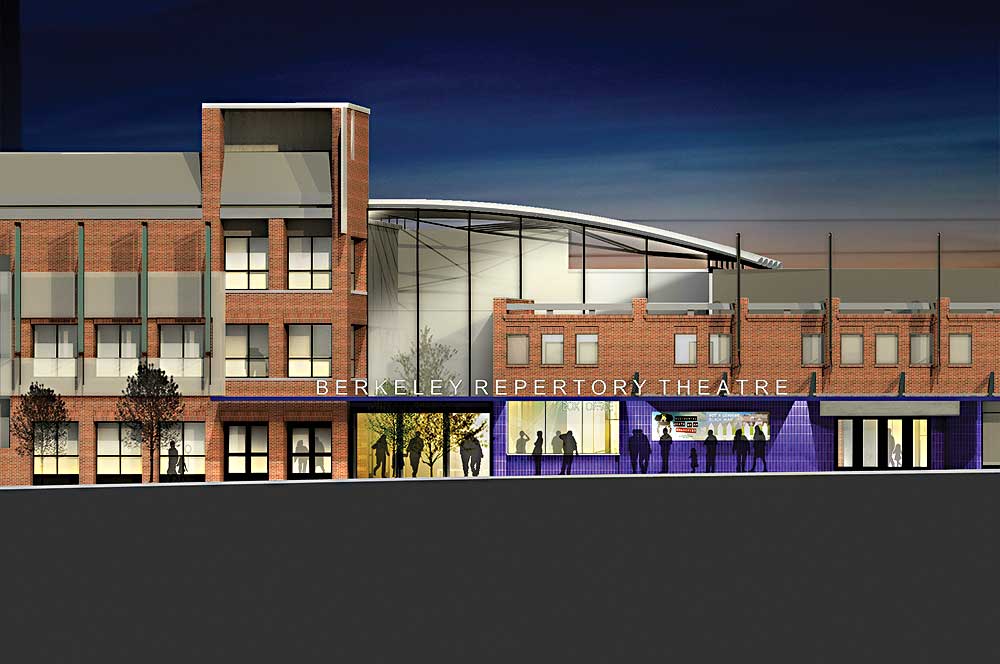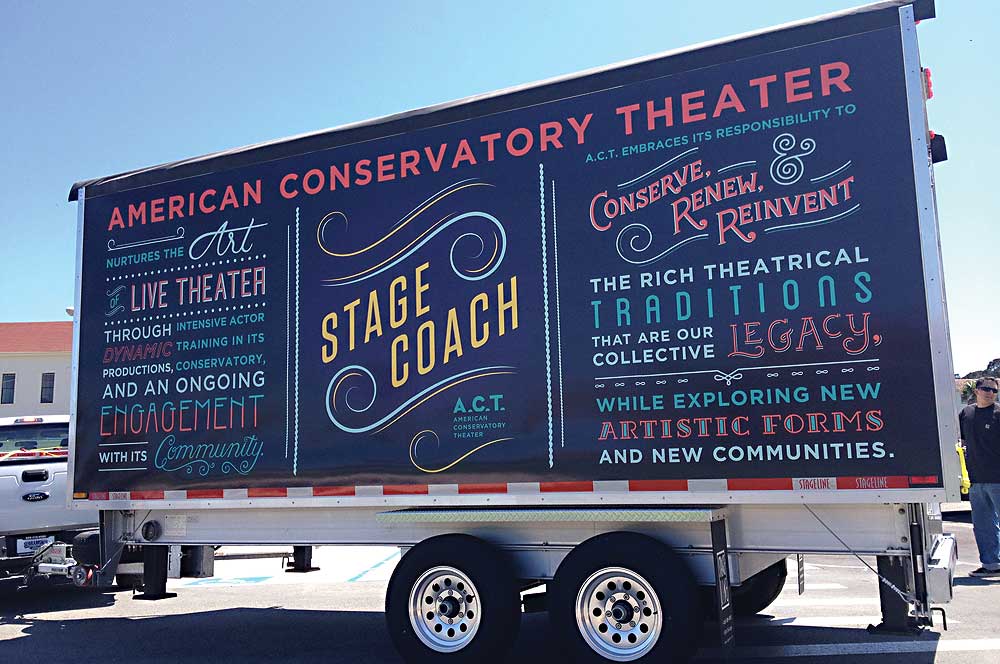TAKING IT TO THE STREETS
 SAN FRANCISCO: So you’re going about your business at a farmer’s market or a pride parade somewhere in the Bay Area, and suddenly a truck pulls up, a stage folds out from a trailer hitched to said truck, and voila! You’re watching a play. That, more or less, is the idea of Stage Coach, a new program of American Conservatory Theater.
SAN FRANCISCO: So you’re going about your business at a farmer’s market or a pride parade somewhere in the Bay Area, and suddenly a truck pulls up, a stage folds out from a trailer hitched to said truck, and voila! You’re watching a play. That, more or less, is the idea of Stage Coach, a new program of American Conservatory Theater.
The mobile “pop-up” stage—a rig typically used to present itinerant music acts—will partner with three existing Bay Area street festivals to create participatory and multigenerational theatre events. There’s Off the Grid, a roving food-truck smorgasbord; 3rd on Third, a monthly community arts gathering in the Bayview neighborhood; and Sunday Streets, a monthly citywide family-friendly arts festival.
Though ACT already has robust education progamming, Rebecca Struch, community producer for the Stage Coach program, says that the idea of a mobile pop-up stage sprang from “a desire for more and deeper engagement with families and adults, beyond just youth and education work.” The program, she emphasizes, is more than just a physical platform for inclusive stagings of original work; it’s also intended to involve ongoing collaboration with community partners to create new work for the portable stage and for other venues. Residencies have already begun in community centers that will result in “some kind of devised piece created by teaching artists and students,” Struch says.
Backed by a two-year, $600,000 grant from the James Irvine Foundation, the Stage Coach is fueled up and ready to roll. “We have generators, so we don’t even need power,” Struch declares.
ALL THE GLOBE’S A STAGE
SAN DIEGO: When Barry Edelstein worked at New York’s Public Theater, he was proud to help launch its Mobile Shakespeare Unit, which brought professional Shakespeare for free to residents of homeless shelters, rehab centers, prisons and other underserved audiences. Since starting in 2012 as artistic director of the Old Globe, he’s been looking for a similar way to “share the wonders” of his theatre with “more and more of our city.” His wish is coming true with “Globe for All,” a series of free and low-cost performances that will tour around to underserved San Diego areas. The inaugural production is All’s Well That Ends Well, directed by Edelstein himself. The program, he says, addresses “our obligation to help overcome whatever barriers—economic, geographical, and cultural—stand between us and the widest possible cross section of our city.”

Starting Oct. 28, Edelstein’s All’s Well, cast with local professional actors, including recent grads of the Old Globe/University of San Diego MFA program in classical acting, will tour to military bases, recreation centers, libraries, centers for the elderly, homeless shelters and correctional facilities, and will be staged in such non-theatrical venues as gymnasiums, cafeterias and multipurpose rooms. One-hour pre-show workshops with Globe teaching artists will also be offered to familiarize audiences with Shakespeare’s language, themes and characters. A low-cost ($10 per ticket) run of the show will be open to all comers Nov. 7–9 at Hattox Hall.
The program builds in part on a previous initiative, the Globe Residency Project, which served southeastern San Diego, home of the Globe’s Technical Center, and featured such highlights as the hip-hop musical Kingdom, Kristoffer Diaz’s Welcome to Arroyo’s, and a community-focused Odyssey helmed by director Lear deBessonet (AT, Sept. 14). The southeastern “leg” of the All’s Well tour will be a free performance at the Jacobs Center for Neighborhood Innovation Celebration Hall on Nov. 2. Go to oldglobe.org.
IN WITH THE NEW

PORTLAND, ORE., and BERKELEY, CALIF.: The West Coast’s new-works cup runneth over with two new programs intended to incubate fresh plays and budding writers. In Portland, Artists Repertory Theatre is the recipient of a $125,000 “Creative Heights” grant from the Oregon Community Foundation to create a “robust new-play development program” and commission eight new plays over the next two years. Four of those plays will be by writers of color, four will be by women, and one will be written for young adults. And one writer from Oregon will be awarded a special commission, dubbed “The Oregon Play Prize,” with a commitment to a full production of the play’s world premiere in a future Artists Rep season.
Part of the grant will go toward hiring a director of new-play development to administer the program, which will include an online video series and a blog to facilitate audience engagement.
Said Damaso Rodriguez, who has been artistic director of the more than three-decade-old company for less than two years, Artists Rep has “always sought out plays that reflect the diversity of human experience, but this will be the first time we will deliberately and specifically commission, curate and develop work by women writers, writers of color and writers of work for young audiences.”
Meanwhile, Berkeley Repertory Theatre’s three-year-old new-work incubator, the Ground Floor, is one focus of a new $50-million fundraising effort, the “Create Campaign.” Around $14 million of that largesse will go to expand the theatre’s Harrison Street campus into a center for artistic innovation. “Each June, artists from all over the country take over the theatre’s administration building to create new work,” says Voleine Amilcar, Berkeley Rep’s director of public relations. The new funds will “help realize an actual home for the Ground Floor by converting the underdeveloped warehouse at the Harrison Campus into artists’ live/work spaces, rehearsal halls and studios.” This next evolution of Ground Floor is scheduled to be completed by 2017.
The campaign will also raise $6 million to renovate the Rep’s Thrust Stage. The remainder of the funds will go to transform the theatre’s courtyard into a covered atrium, add a patron lounge and updated ADA-accessible restroom facilities, and shore up the organization’s annual fund, capital reserve fund and staffing.
“This is a community that has always understood that it takes a village to support something important,” says Susan Medak, Berkeley Rep’s managing director, citing the push to build the 400-seat Thrust Stage in the 1970s and another to create the 600-seat Roda Theatre in the ’90s. “We’re now at another one of those crossroads. We’re asking the community to help us be good stewards of our facilities, commit to our core programs and invest in our people.” Go to artistsrep.org and berkeleyrep.org.
VIVE LE DIFFERENCE

NEW YORK CITY: The annual Crossing the Line festival, a citywide, interdisciplinary, international arts fête presented by the French Institute Alliance Française (FIAF), is back for an encore—its eighth. But this ain’t all about the French, mes chères. On the program is a screening of a new documentary film about New York’s own Nature Theater of Oklahoma; the U.S. premiere of N.Y. choreographer Trajal Harrell’s provocative dance series Twenty Looks or Paris Is Burning at the Judson Church; a new show by “cabaret messiah” Justin Vivian Bond; New York–based theatre artist Aaron Landsman’s Republic of New York: Perfect City discussions, a free “performed public meeting” on urban issues, Oct. 6; N.Y.-based 600 HIGHWAYMEN’s haunting Employee of the Year, with music by David Cale, Oct. 15–16; and arguably the most high-profile event in the festival, Killer Road, for which punk poet Patti Smith joins Soundwalk Collective and her daughter, Jesse Smith, in a performance of poetry by Factory muse and mainstay Nico, Oct. 2.
Rounding out the fest’s international representation are such attractions as French multimedia artist Julie BÄna’s Solo Show, through Oct. 18; a provocative, Cage-like, empty-space meditation We Are Still Watching, through Oct. 3, and a participatory piece for kids called Partituur, through Oct. 5; Colombian-born visual artist Jessica Mitrani’s Traveling Lady, a tribute to 19th-century American journalist Nellie Bly, performed by Almodovar muse Rossy de Palma, Oct. 10–11; and Japan-born composer/sound artist Ryoji Ikeda’s immersive superposition, Oct. 17–18. Venues range from the Metropolitan Museum of Art to Abrons Arts Center, from the Brooklyn Academy of Music to the digital screens of Times Square. This particular revolution, it seems, will be televised. Go to fiaf.org.
MOBILE MOMENTS
NATIONWIDE: Earlier this year, a tech developer asked eight arts organizations to forgo those obligatory turn-off-your-cellphones messages at the beginning of performances. The goal was not to unleash a torrent of disruptive Tweets and Instagram selfies within their hallowed halls but to explore the potential for on-site mobile content—a largely untapped area for most arts organization, who have focused their efforts on off-site content, in large part for fear of detracting from the live performance.
But what if, instead of just checking their e-mail before a show or at intermission, audiences had the chance to read relevant program information or watch performance videos related to their experience there—even find out about, and buy tickets to, future shows at the same venue? After all, they’re already checking IMDb to figure out where they’ve seen that actor, or Shazam-ing that pre-show mix to find out the name of that song; why not reach them right where they’re looking anyway?
The results of a study by InstantEncore are highlighted in a new white paper, “Engaging at the Event: Audience Expectations for Live Performance in the Mobile Age.” InstantEncore’s “At the Event” features—designed to deepen audience’s knowledge, foster communication among patrons and encourage return attendance—were tested at more than 40 performances at eight arts organizations, including Berkeley Repertory Theatre and the Gertrude C. Ford Center for the Performing Arts in University, Miss., last spring. Participating organizations reported a 47-percent increase in the total number of app users, with a whopping 92 percent of mobile app users engaging with features at the pilot performances.
“The results of the At the Event pilot program clearly indicate that arts patrons do indeed experience mobile moments in performance venues,” the report concluded, “and they respond positively to having an app with features available to complement the live performance.” Visit instantencore.com


